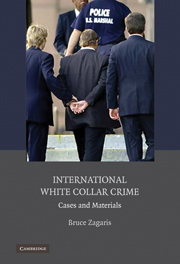Book contents
- Frontmatter
- Contents
- 1 Introduction
- 2 Taxation
- 3 Money Laundering and Counterterrorism Financial Enforcement
- 4 Transnational Corruption
- 5 Transnational Organized Crime
- 6 Export Control and Economic Sanctions
- 7 Extraterritorial Jurisdiction
- 8 International Evidence Gathering
- 9 Extradition and Alternatives
- 10 International Prisoner Transfer
- 11 The United Nations
- 12 The World Bank Group
- 13 INTERPOL
- 14 Economic Integration and Business Crimes
- Index
- References
10 - International Prisoner Transfer
Published online by Cambridge University Press: 05 June 2012
- Frontmatter
- Contents
- 1 Introduction
- 2 Taxation
- 3 Money Laundering and Counterterrorism Financial Enforcement
- 4 Transnational Corruption
- 5 Transnational Organized Crime
- 6 Export Control and Economic Sanctions
- 7 Extraterritorial Jurisdiction
- 8 International Evidence Gathering
- 9 Extradition and Alternatives
- 10 International Prisoner Transfer
- 11 The United Nations
- 12 The World Bank Group
- 13 INTERPOL
- 14 Economic Integration and Business Crimes
- Index
- References
Summary
Hypotheticals
A. Your law firm is asked to represent Mr. X. In 1988, the U.S. Attorney charged him with tax crimes, wire and mail fraud, and embezzlement from a privately held firm where he was a principal. A few months after the indictment, a publicly held firm was acquired. However, in the previous year, Mr. X. had become a national of the Netherlands and began living in that country. In 1998, the United States commenced extradition proceedings, and finally, in 2004, a Netherlands court ruled that Mr. X. was extraditable. His counsel appealed, but Mr. X. fled the country.
In 2006, Mr. X., now approximately fifty years old, is arrested in Spain and accused of using a false identity. Spanish authorities are also investigating Mr. X. on potential money laundering charges. When his family consults you, Spanish authorities are not yet aware of Mr. X.'s identity. However, they have seized his briefcase, which contains a diary and phone book, and customs officials have noted his American accent.
Mr. X. has two former wives, one of whom resides in the United States with a child they had together. Mr. X's second wife resides in the Netherlands, with two children she had with him. Over the last three years, Mr. X. has had a relationship with a Dutch national, and they want to marry.
Mr. X. says that his goals are to avoid extradition to the United States.
- Type
- Chapter
- Information
- International White Collar CrimeCases and Materials, pp. 365 - 401Publisher: Cambridge University PressPrint publication year: 2010



